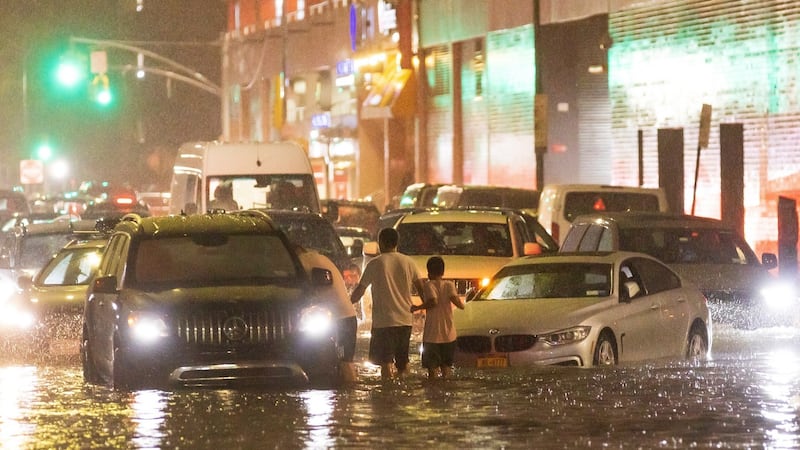The New York area struggled on Thursday to overcome a devastating and deadly rainstorm brought on by the remnants of Hurricane Ida as local leaders acknowledged that the region would need to adjust to a reality in which extreme weather events were the norm.
At least 23 people were killed by the storm, which left more than 150,000 homes in New York, New Jersey and Pennsylvania without power. A tornado in southern New Jersey levelled a stretch of houses. States of emergency remained in effect across the region by midday on Thursday, as officials sought to get a handle on the unanticipated damage.
At a news conference in Queens on Thursday morning, Governor Kathy Hochul of New York said that she had received a call from president Joe Biden, who she said “offered any assistance” as the state assessed the damage from Ida, a storm that she said represented a new normal.
“We need to foresee these in advance and be prepared,” she said.
“Global warming is here,” said Eric Adams, the Democratic nominee for mayor.
The deluge of rain on Wednesday – more than 15cm fell in just a few hours – turned streets and subway platforms into rivers. Emergency responders in boats rescued people from the rooftops of cars. Hundreds of people were evacuated from trains and subways.
The rain broke records set just 11 days before by Tropical Storm Henri, underscoring warnings from climate scientists of a new normal on a warmed planet. Hotter air holds more water and allows storms to gather strength more quickly and grow ever larger.

Though the region awoke to a sunny day, New York City’s subway lines remain at least partly suspended, along with commuter rail service across the region. Airports are open, but hundreds of flights have been cancelled. Rescues continued, and some rivers in New Jersey and Pennsylvania were still rising.
In New York City, the dead ranged in age from a two-year-old boy to an 86-year-old woman, police said. Some drowned in basement apartments in Queens, where a system of makeshift and mostly illegally converted living spaces has sprung up. Five people were found dead in an apartment complex in Elizabeth, New Jersey, city officials said on Thursday. Another death occurred in Passaic, New Jersey, where the Passaic River breached its banks and fish flopped in the streets.
The 8cm of rain that fell in Central Park in one hour on Wednesday eclipsed the record-breaking one-hour rainfall of almost 5cm on August 21st. The National Weather Service, struggling to depict the level of danger, declared a flash-flood emergency in New York City for the first time.
In Bergen County, New Jersey’s most populous county, County Executive James Tedesco, a former firefighter, said on Thursday: “We have not complete devastation but close to it. This is as bad as I’ve ever seen it.”
The remnants of Ida swept across parts of southern New England on Thursday.
As of late Thursday morning, the system was located near eastern Long Island, New York, moving northeast at 45 kmph and accelerating toward Cape Cod, Massachusetts, with maximum sustained winds of 45 kmph. After heavy rain overnight, more rain was expected across parts of Connecticut, Massachusetts and Rhode Island, where flash flood warnings were in effect, the weather service said.
The weather service warned of life-threatening flash flooding in urban areas, including on highways and below underpasses, and in areas near streams and small rivers.
Several rivers in Connecticut were approaching or had crested above moderate flood stage, the weather service said, including the Mount Hope River in Warrenville, the Quinnipiac River in Southington, and the North Branch Park River in Hartford.
“While many rivers and streams are swollen, a total of 15 river forecast points are in flood stage” in Connecticut, Rhode Island and Massachusetts, the weather service said on Thursday. “River flooding will remain a concern.”
As of 11am on Thursday, more than 22cm of rain had fallen in New Bedford, Massachusetts, and nearly 18cm had fallen in Middletown, Connecticut. Portsmouth, Rhode Island, was drenched with more than 20cm of rain, while about 10cm had fallen in Hudson, Maine, according to the weather service’s Weather Prediction Service.
Photos circulating on social media showed some of the worst flooding and storm damage. Television news cameras captured a road surface that crumbled in Portsmouth, with one car dangling over the broken pavement. The Police Department in Waltham, Massachusetts, shared an image of several school buses submerged in floodwater.
Although the rainfall was beginning to move out of the area, there were still many flooded roads throughout southern New England.
“It will take time for the water to recede in these areas,’’ the Weather Service in Boston said. “Do not attempt to cross any flooded roads this morning. Turn around don’t drown!”
Rhode Island has already seen two tropical storms make landfall this hurricane season: Henri last month, and Elsa in July.
This article originally appeared in The New York Times.











